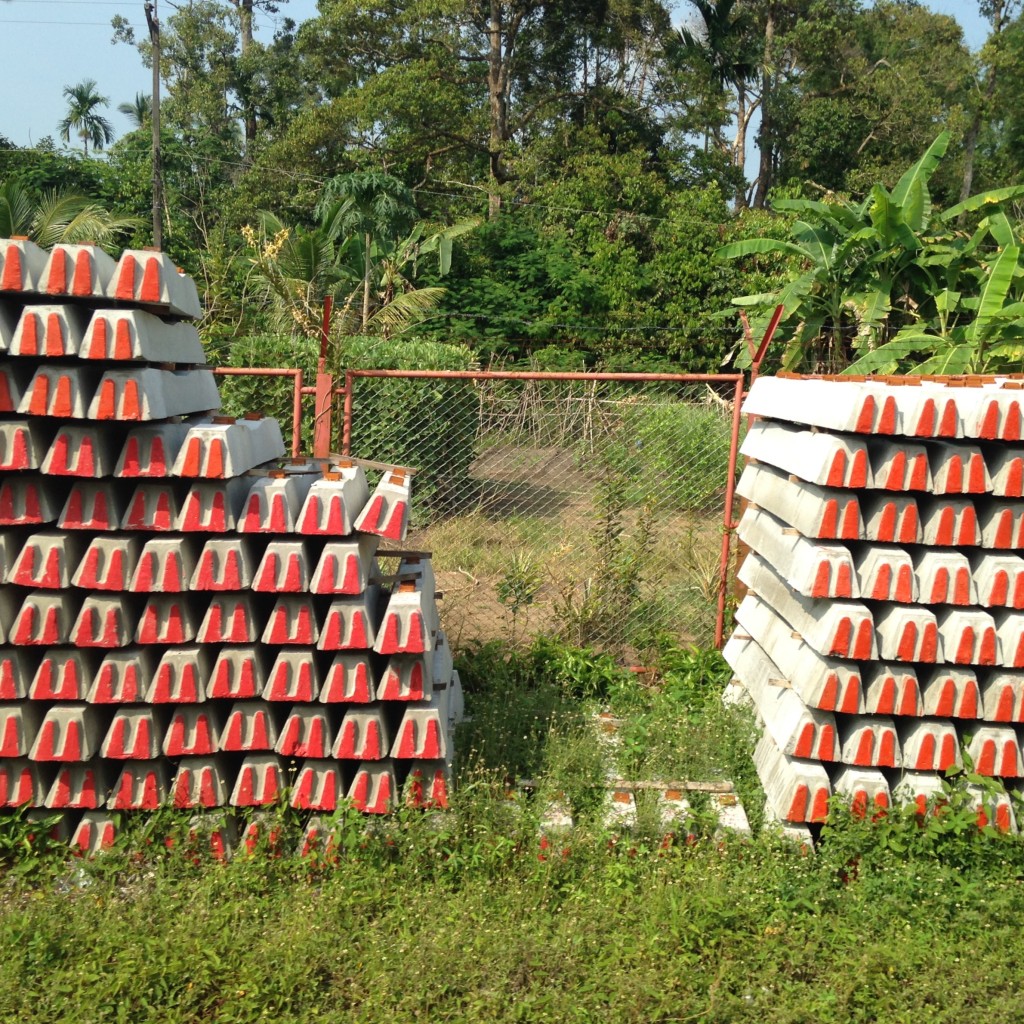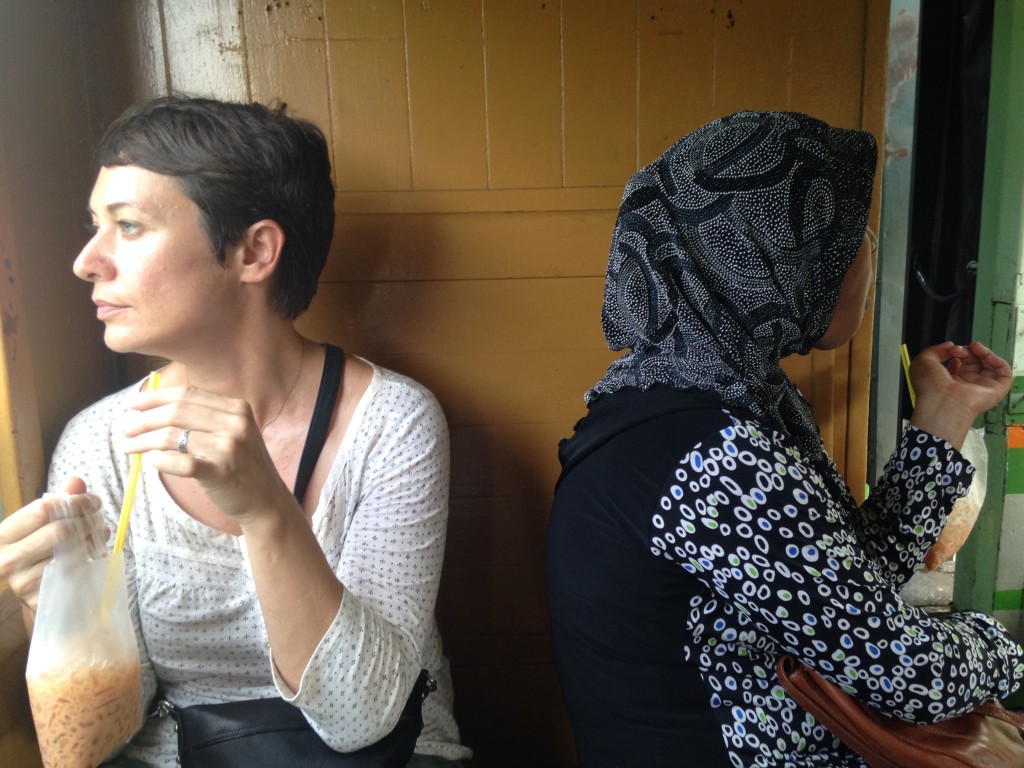
Crossing Conflict: Southeastern Thailand
Shhh…here is a secret: some of the best beaches in Thailand are utterly empty and largely undeveloped.
How can treasures so valuable be unexploited?
The white sands are empty because one side of the conflict doesn’t want bikini-clad, beer-swilling westerners in their territory. The white sands stay empty because the other side of the conflict wants Thailand to seem perfectly safe. Expanding resorts into this seemingly pristine territory would likely turn tourists into targets.
We’ve noticed a few practicing Muslims in Bangkok and Ayutthaya. Women who wear hijab are easiest to spot and we’re mostly likely to see them near a university.

A food vendor in Hua Hin station awaits a south-bound train. In the bottom of the frame you can see that the top layer of her treats bear the star and crescent, a sign that the food so marked is halal. Click the photo to enlarge.
These folks almost certainly call the very southeast of Thailand home, and their first language is probably the northernmost dialect of Malay, Yawi, not Thai.
We know a cultural shift is coming in Hua Hin, where the southbound food vendors on the train start carrying and clearly marking some of their snacks as halal.
We know we’re getting closer when roadside establishments begin marking their signs in Malay and in Jawi, an Arabic script that gained popularity for writing Malay in the 14th century CE and still used by historically Malay Muslims.

Truckstop signage between Prachuap Khiri Khan and Hat Yai. The sign with the white arrow has Thai in the top position, romanized Malay in the second position, and Jawi in the third slot. Who’s the mustachioed gent with the red plaid scarf? Search me, he didn’t say much. Click the photo to enlarge.
Hat Yai, Thailand’s third largest city, is where tourism comes to a screeching halt. There is a Thai solider for every two or three passengers in the Hat Yai train station. Southeast of Hat Yai, a queerly polite war is in progress.
I feel strange writing the words ‘queerly polite’ to describe a conflict where people—soldiers, insurgents, and civilians—are dying nearly every day, yet almost none of the region’s violence gets directed at people like me, and that seems polite. Every day tourists scuttle back and forth across the region to the eastern Malay border, and we are not targeted by insurgents, though hurting us would be an easy way to hurt the Thai government.
It is not just the presence of soldiers that makes it obvious we’ve entered a new region. Suddenly goats are grazing near the roads and rails. Rooting pigs are gone, because many people here eat halal food, and pork can never be halal. Probably half the men on the train are wearing songkok, the cap popular with Muslim men in southeast Asia. Eighty to ninety percent of the women are wearing hijab, including some girls I guess to be three or four.
Signs of conflict unavoidable. Between Hat Yai and Sungai Kolok at the Malaysian border, every rail station (The railway is a government enterprise and therefore a target.) is surrounded by barbed wire to reduce the chances of raiders getting in close or of bombs being planted (Improvised explosive devices, like those used in Iraq and Afghanistan, are increasingly common.). The gates are opened for the trains to come in, and closed after they depart. Passengers entering the stations are searched. Every third or fourth station has a significant barracks, sandbagged, fenced, and watchfully guarded. New steel rails, concrete ties, and fresh gravel for ballast are stockpiled in station compounds, but no crews are working to upgrade the railway infrastructure.

Concrete ties stockpiled inside one of the rail station strongholds in southeastern Thailand. Between the two piles of rails you can see the chain-link and barbed-wire fence that surrounds the enclosure. Click the photo to enlarge.
Our train is rolling through an incredibly lush and complicated landscape. Pale, skinny, almost white-barked rubber trees in neat plantation rows are spreading their deep green leaves on both sides of the tracks: commerce is still happening. Small clumps of bananas, shorter, with wider, longer, darker leaves attest to small farms working in gaps between the rubber plantations. Humidity proves the warm ocean is just out of sight. To the west limestone hills thrust up sharply.
Politically it’s complicated, too. There are at least five known insurgent groups, but there’s no evidence they talk to each other, so it’s hard for the Thai government to have meaningful, settlement-oriented dialog, even if the government were capable of such dialog.
Most people aren’t insurgent or militant. There is a fascinating moment as we pull into one of the more southern stations. We’re sitting near the end of the rail car, Alison closest to the exit, me on the bench across. A woman in hijab joins the lineup to debark.
She pats me on the shoulder.
It’s not a “Hey, buster, get out of my way,” tap or a dismissive “Be gone from my sphere,” flick.
No, it was more of a “Happy to see your pale face in these parts. Sticking around?” pat of appreciation.
Alison receives a longer, more intimate pat. Lingering fingers give special attention to Alison’ sleeve, a long, tasteful sleeve, with a Thai sensibility to the print, that Alison carefully chose as a way to honor the Muslim sense of modesty while maintaining her own sense of fashion.

Alison and her sleeves sip Thai iced tea from a bag on a train bound for Sungai Kolok. The woman seated next to her is not the one who delivered the affectionate gesture, but from this picture you can get a sense for typical women’s dress in southeastern Thailand. Click the photo to enlarge.
The air brakes hiss as we receive our endearment, and then, with the Siamese smile the government wants tourists like us remember, she is gone into the conflict zone.
Ducking across the Malaysian border,
Chris
Recent Comments